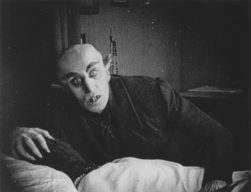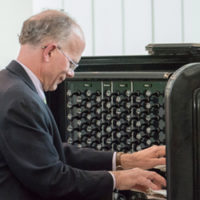
This past week, Northeast Ohio hosted two performances of the classic horror film Nosferatu — one in Youngstown’s Stambaugh Auditorium and one in Cleveland’s Severance Hall.
Both were accompanied by organ scores and performed on restored E.M. Skinner organs.
Peter Richard Conte at Stambaugh Auditorium in Youngstown (October 23)
by Robert Rollin
On Sunday afternoon, October 23, Stambaugh Auditorium’s neoclassic environs were filled to the brim with an audience of determined early Halloween celebrants for a viewing of the silent movie Nosferatu. The film was screened with an organ accompaniment performed by Peter Richard Conte, who has been organist of the huge Wanamaker (now Macy’s) department store organ in Philadelphia for over 25 years.
Playing from notes, Conte provided no introduction, adding a sense of mystery to the afternoon. His lush, Schumannesque musical score meshed beautifully with the movie.
For Nosferatu: A Symphony of Horror (1922), director F. W. Murnau adapted and altered the plot of Bram Stoker’s 1897 classic Gothic horror novel, Dracula, without getting copyright permission from Stoker’s widow. Though a court ordered the destruction of the negatives, a few prints survived, and the film has gone on to become a cult classic.
In Henrik Galeen’s screenplay, Dracula became “Count Orlok,” and vampire “Nosferatu.” The story moved from Romania to Wisborg, a fictional north German harbor town. The film also added the ideas of the vampire’s inability to survive in daylight and of the rats in Nosferatu’s earth-filled coffin bringing plague to Wisborg by boat.
The film begins with Thomas Hutter, a real estate clerk living in Wisborg, traveling to Transylvania at the behest of his boss to visit Count Orlok, a new client. Orlok welcomes him to his castle, and when Hutter cuts himself during dinner, the Count tries to suck the blood from the wound.
He finds Orlok sleeping in a coffin the next day and runs away in terror. Later he sees Orlok piling coffins into a coach. The coffins are shipped by boat to Wisborg. When an unsuspecting seaman opens the coffin, many rats emerge, and one by one the crew dies from the plague.
Ellen, who has read that a pure-hearted woman can destroy the monster, invites him in by the window. Sacrificing herself, she destroys Nosferatu by keeping him occupied until the light of day kills him.
In Act I, when Hutter travels to the Carpathian Mountains by horseback and coach, Conte used low, dark pedal tones and descending scales to create tension. Dark sounds and thick chords continuedd in Act II, when Orlok ominously remarks, “Your wife has a lovely neck.”
Act III is aboard ship. Conte’s rapid tempo with loud, punctuated chords suggested the horrific deaths of the crewmembers. In Act IV, fortissimo chords announced Nosferatu’s arrival in Wisborg.
Conte employed a recurring descending motive in Act V to depict the townspeople’s fear of the plague. Finally a majestic theme depicted Ellen’s courage in the face of certain death.
Conte’s performance was filled with musical pyrotechnics and great variety of dynamics. The final applause was thunderous.
Todd Wilson at Severance Hall in Cleveland (October 25)
by Mario Buchanan
Severance Hall looked quite different on Tuesday evening, October 25: the lights were dimmed, the audience was in jeans and t-shirts, and the stage was empty except for a projection screen with the word “Nosferatu” and the console of the Norton Memorial Organ.
A large, enthusiastic crowd patiently waited for acclaimed Cleveland organist Todd Wilson to take a seat and transport us away to the land of things that go bump in the night with his accompaniment to the silent film Nosferatu.
Todd Wilson spoke about the film’s “sketchy past” — it was an unauthorized adaptation of Dracula. Bram Stoker’s family, who owned the rights to his book, weren’t happy with the release of the movie and summoned the fiilm’s director into court. Although all prints of the film were ordered destroyed, a few years later, it began to show up in the United States.
Though we came to get our bones chilled and our spines tingled, Wilson couldn’t help appearing in his Cleveland Indians baseball cap, which sat on the organ next to him throughout the performance. Wilson began the evening with an “overture,” Bach’s famous Toccata and Fugue in d, cutely prefaced with the “Charge!” theme.
With all the lights off in the hall, and only a single light on the organ, the audience was drawn towards the light of the console. As the organ roared into life, it cast a gloomy shadow inside Severance Hall. You could almost see bats flying around the auditorium. Drawing on the entire resources of the E.M. Skinner organ, Wilson alternated between manuals and made use of the 32-foot stops and the battery of reeds at his disposal. Wilson and Bach won a rousing round of applause.
Wilson played his entire 90-minute score for Nosferatu without assistance of sheet music, watching the movie just like the rest of us. The role of a silent movie accompanist is quite challenging. You have to know the movie’s storyline and be creative in invoking different feelings for each scene.
Another challenge is comedic timing. In the hands of a less-skilled organist, the parts of the movie that require comic relief can become dull. Wilson showed his expertise and experience as a comedian, intertwining the familiar flute tune from Grieg’s Peer Gynt Suite throughout the morning scenes. He used different keys to show color changes, which made the audience roar into laughter every time. During the scenes of people rowing boats, Wilson humorously snuck in familiar tunes like Row, Row, Row Your Boat and Sailor.
Organ music fans in the crowd would have noticed some familiar references, ranging from Boëllmann’s Suite Gothique to Widor’s Sixth Organ Symphony, and from Mendelssohn’s organ sonatas to Liszt’s Prelude and Fugue on BACH. Rather than playing these straight, Wilson made these tunes his own and developed them throughout the movie.
At the end of Nosferatu, the audience erupted in applause, expressing their enjoyment of the evening. It was an amazing experience that left everyone asking the same question about Wilson: “How in the world could he do all that!?” The audience went back to planning their Halloween festivities, reminded of the amazing musical talent we have in Cleveland.
Published on ClevelandClassical.com November 1, 2016.
Click here for a printable copy of this article





